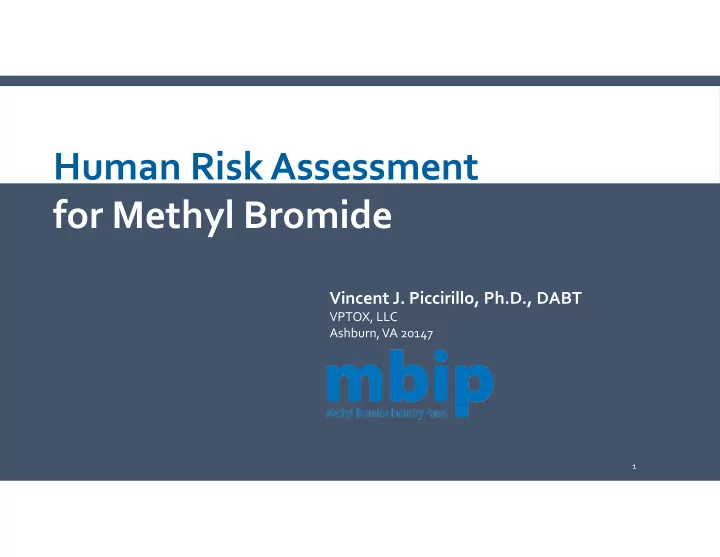

Human Risk Assessment for Methyl Bromide Vincent J. Piccirillo, Ph.D., DABT VPTOX, LLC Ashburn, VA 20147 1
BACKGROUND The North Carolina Department of Environmental Quality, Division of Air Quality (DAQ) issued a report entitled “Risk Analysis and Acceptable Ambient Level Recommendation for Methyl Bromide” on February 22, 2019 that proposes 5 μ g/m3 methyl bromide (0.005 mg/m3 or 1 ppbv) in air as the 24 ‐ hour N.C. Acceptable Ambient Level (AAL). 2
BACKGROUND This proposed AAL is based on the chronic reference concentration (RfC) established by the U.S. EPA IRIS program from a 29 ‐ month inhalation toxicity study of methyl bromide in rats (Reuzel, 1987). The selection of the nasal endpoint for potential chronic (one year or longer) exposure of bystanders in areas of log fumigation would potentially be consistent with sound science and USEPA if used to establish chronic exposure enpoints. However, DAQ is recommending that the RfC be used to establish a 24 ‐ hour maximum ambient air limits applicable to acute and other shorter term exposures. This approach is flawed and without precedent from any regulatory authority. The recognized approach by USEPA and other regulatory bodies is to conduct risk assessments that match potential human exposure with appropriate toxicological endpoints from studies of similar duration. 3
ACUTE ENDPOINT SELECTION EPA’s “Hazard Identification ‐ Toxicology Endpoint Selection” (August 11, 1998) Provides guidance in selection of toxicological endpoints appropriate to potential human exposure durations. Primary studies for acute endpoint selection Acute Neurotoxicity Study in Rats Prenatal Developmental Toxicity Studies Other studies such as subchronic, chronic, reproductive or carcinogenicity studies if any toxicological effects are seen within the first few days of dosing and can be extrapolated to an acute event. 4
ACUTE DATA IS READILY AVAILABLE A primary rationale provided in the DAQ document for relying on a chronic endpoint for an acute exposure limit is that DAQ found no data on acute levels from reliable sources. This statement is incorrect. During reregistration and registration of MB pesticides, USEPA selected toxicological endpoints relevant to acute, short and intermediate and chronic exposure durations. 5
METHYL BROMIDE ACUTE ENDPOINT Although an Acute Neurotoxicity Study via inhalation with a NOAEL of 100 ppm for neurobehavioral effects was available, EPA selected an inhalation developmental toxicity study in rabbits as having the most conservative NOAEL for acute inhalation risk assessment for all bystanders. 6
METHYL BROMIDE ACUTE ENDPOINT The developmental toxicity study (Breslin et. al., 1990) was conducted with pregnant New Zealand white rabbits exposed for six hours/day on gestation days 7 through 19 to methyl bromide concentrations of 0, 20, 40 or 80 ppm. At 80 ppm, maternal toxicity included decreased body weight gain and clinical signs of neurotoxicity characterized by right ‐ sided head tilt, ataxia, lateral recumbency and lethargy. At 80 ppm, developmental effects a low incidence of several findings were noted. The NOAEL for both maternal neurotoxicity and developmental toxicity was 40 ppm. 7
METHYL BROMIDE ACUTE INHALATION RISK ASSESSMENT USEPA used the 40 ppm NOAEL from the rabbit developmental toxicity study as the endpoint for acute inhalation exposure. The Human Equivalent Concentration for the commodity bystander scenario was calculated to be 40 ppm using methodology similar to that of DEQ. USEPA assigned a 30X uncertainty factor (UF) (3X UF for animal to human extrapolation with dosimetric adjustment, and UF 10 for human variability) to this value. Using the approach of DAQ, this would result in a 24 ‐ hour Acceptable Ambient Level (AAL) of 1.3 ppm for acute bystander inhalation exposure. 8
DAQ MISCLASSIFIED METHYL BROMIDE CARCINOGENICITY DAQ appears to have not considered best available data. The DAQ document indicated that methyl bromide was “not classifiable as to human carcinogenicity” based on the results from an inadequate oral gavage study with methyl bromide. Result conflicts with USEPA classification of methyl bromide as a not likely human carcinogen . (USEPA, 2007; USEPA, 2013). USEPA reviewed the chronic toxicity/ carcinogenicity studies for methyl bromide via the inhalation route in rats (Reuzel et. al, 1987) and in mice (NTP, 1992). 9
DAQ’S SELECTION OF CHRONIC ENDPOINTS ADDS INAPPROPRIATE UNCERTAINTY FACTOR To the extent DAQ intends to recommend appropriate duration chronic exposure limits (e.g., 1 ‐ year or longer), current document contains uncertainty factor errors The IRIS RfC already includes appropriate uncertainty factors 3X UF for animal to human extrapolation with dosimetric adjustment 10X UF for human variability 3X UF for extrapolation from a LOAEL to a NOAEL EPA rounded to a cumulative 100X UF DAQ inappropriately recommends an additional 3x uncertainty factor 10
DAQ ADDED AN UNNECESSARY UNCERTAINTY FACTOR The DAQ document recommends an additional 3X UF be placed on the IRIS chronic RfC as to reduce the potential for adverse health effects to the subpopulation that possess the Phase II GSTT1 enzyme variant that predisposes them to increased neurotoxic effects. This additional UF is not appropriate. The RfC methodology takes into consideration many pharmacokinetic (PK) differences but not pharmacodynamic (PD) differences between species and for this reason, the UF for interspecies extrapolation is reduced to 3x (to account for the PD differences) while the UF for intraspecies variation is retained at 10x. 11
DAQ ADDED AN UNNECESSARY UNCERTAINTY FACTOR First, the 10X interspecies UF for human variability was applied to the nasal olfactory effects. This “interspecies” uncertainty factor is specifically applied for the protection of sensitive populations which would include those with the Phase II GSTT1 enzyme variant. Secondly, neurotoxicity is the effect of concern in those with the Phase II GSTT1 enzyme variant. The concentration inducing nasal effects and subsequent AAL is protective of neurotoxicity. A number of studies evaluating neurotoxicity by validated Functional Observational Battery (FOB) and motor activity procedures or noted by study clinical signs or histopathological findings have been conducted. 12
THANK YOU Vincent J. Piccirillo, Ph.D., DABT VPTOX, LLC Ashburn, VA 20147 13
Recommend
More recommend